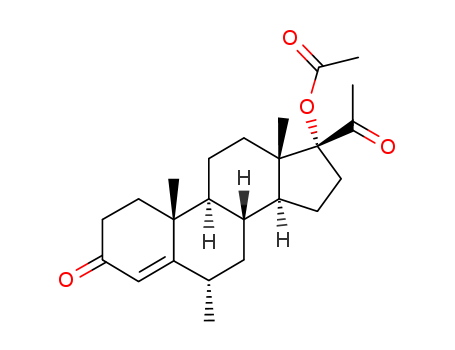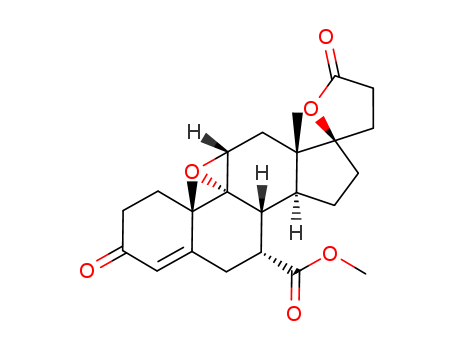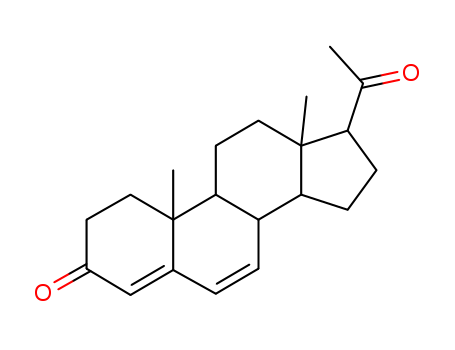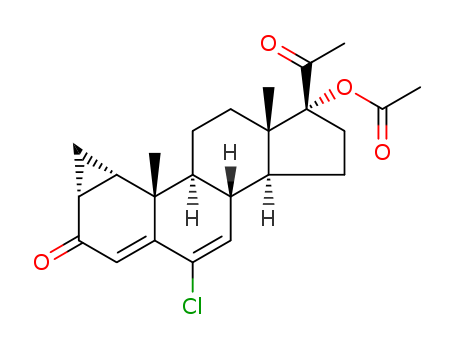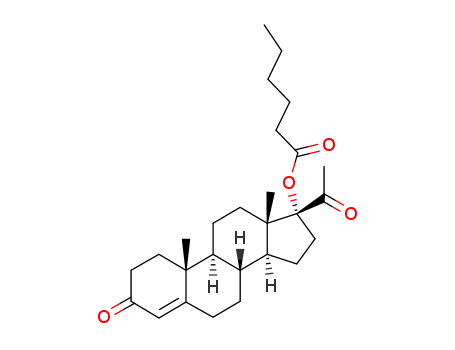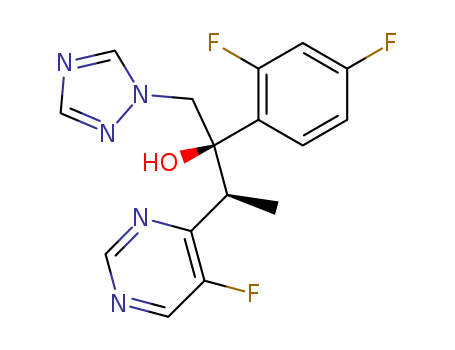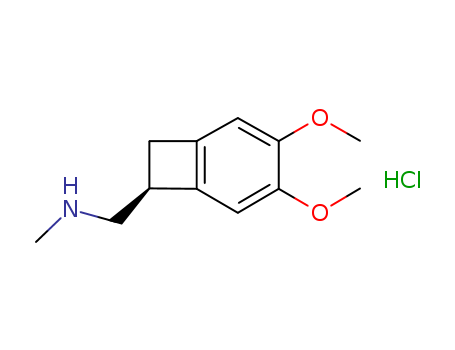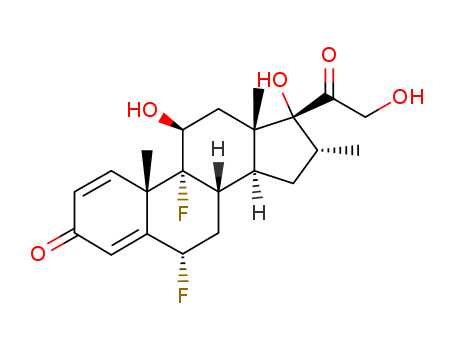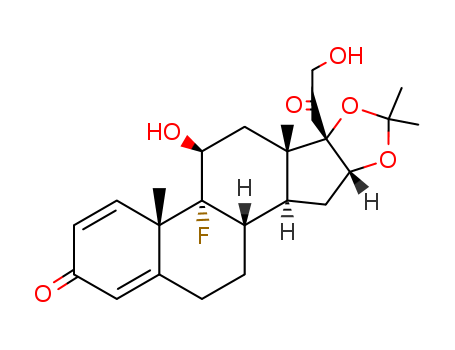
76-25-5
- Product Name:Triamcinolone Acetonide
- Molecular Formula:C24H31FO6
- Purity:99%
- Molecular Weight:434.505
Product Details;
CasNo: 76-25-5
Molecular Formula: C24H31FO6
Appearance: White solid
Buy Reliable Quality Triamcinolone Acetonide 76-25-5 Factory Sells with Efficient Transportation
- Molecular Formula:C24H31FO6
- Molecular Weight:434.505
- Appearance/Colour:White solid
- Vapor Pressure:1.04E-15mmHg at 25°C
- Melting Point:274-278°C (dec.)
- Refractive Index:1.588
- Boiling Point:576.9 °C at 760 mmHg
- PKA:12.87±0.10(Predicted)
- Flash Point:302.7 °C
- PSA:93.06000
- Density:1.33 g/cm3
- LogP:2.41880
Triamcinolone acetonide(Cas 76-25-5) Usage
|
Appearance and properties |
Triamcinolone acetonide, its acetate form appears to be white or white-like crystalline powder. The drug is odorless, with bitter taste. It is hardly soluble in water, slightly soluble in ethanol, soluble in chloroform, and slightly soluble in acetone. |
|
Glucocorticoid drugs |
Triamcinolone acetonide is a kind of long-term glucocorticoid drugs which is now widely used in clinical Dermatology of China. It belongs to adrenocorticotropic hormone drugs. It is the derivative of Triamcinolone, and with the same function as Triamcinolone. Triamcinolone acetonide functions in anti-inflammatory, anti-allergic, anti-itching and shrinking capillaries. What’s more, besides its weak water-sodium retention, the effect of Triamcinolone acetonide for anti-inflammatory, anti-allergic is much stronger and more durable than hydrocortisone (10 to 30 folds), and prednisone. It can also treat bronchial asthma by aerosol inhalation with very strong and durable effect. Triamcinolone acetonide has better efficacy on local treatment compared with triamcinolone. It is Oral absorbed easily. Taking orally 5mg of the drug yields a bioavailability of about 23%. Its plasma concentration reaches peak (105 ng/mL) within one hour with the half-life is being 2 hours; It has a slow intramuscular absorption rate which takes effect within hours, and gives maximal effect within 1 to 2 days. The effect can be maintained for 2~3 weeks; the absorption rate of intradermal and intra-articular injection of the drug is low, but has a long-lasting effect; generally the efficacy can be maintained for more than 1-2 week per injection. This product has a low binding rate with plasma albumin protein, and is metabolized into non-active product in the liver, kidneys and tissues which is then further excreted by the kidneys. It also has a long-lasting effect upon local injection. Moreover, topical ointments can also produce a good effect. Clinically triamcinolone acetonide is used for treatment of various skin diseases such as atopic dermatitis, contact dermatitis, seborrheic dermatitis, neurodermatitis, eczema, psoriasis, psoriasis, lichen planus and skin pruritus, as well as bronchial asthma, rheumatoid arthritis, acute sprains, chronic ache in back and legs, frozen shoulder, tenosynovitis, ophthalmic inflammation, oral mucosal congestion, erosion, ulcers, granulomatous cheilitis, and oral mucosa chronic infectious diseases, Furthermore, it can also be used for local injection treatment in keloid, cystic acne, discoid lupus erythematosus, alopecia areata and other small area of damages. Triamcinolone acetonide nasal spray can be used for the prevention and treatment of perennial, seasonal allergic rhinitis, and vasomotor rhinitis. Intra-articular injection of this drug can eliminate inflammation and pain, swelling or can alleviate, pain, stiffness and swelling feeling. |
|
Uses |
It is adrenal cortex hormones drugs used for treating diseases such as neurodermatitis, eczema, psoriasis, joint pain, and asthma. |
|
Category |
Toxic Substances. |
|
Toxicity grading |
Highly toxic. |
|
Acute toxicity |
Subcutaneous-rat LD50: 13.1 mg/kg; intraperitoneal-Mouse LD50: 105 mg/kg. |
|
Flammability hazard characteristics |
Combustible; combustion produces toxic fumes of fluoride. |
|
Storage Characteristics |
Treasury: ventilation, low-temperature and dry; store separately from food raw materials. |
|
Extinguishing agent |
Dry powder, foam, sand, carbon dioxide, water spray. |
|
Description |
Triamcinolone acetonide is a synthetic corticosteroid. It decreases cytokine levels, the firing rate of sensory neurons, and mechanical hypersensitivity in a rat spinal nerve ligation model when used at a dose of 1.5 mg/kg prior to and following surgery for three days. Triamcinolone acetonide also decreases outflow facility in a mouse model of steroid-induced glaucoma when 20 μl of a 40 mg/ml suspension is administered subconjunctivally. Formulations containing triamcinolone acetonide are used in the treatment of diabetic macular edema. |
|
Chemical Properties |
White Solid |
|
Originator |
Kenalog,Squibb,US,1958 |
|
Indications |
Triamcinolone acetonide (Aristocort, Kenalog) is a synthetic fluorinated corticosteroid. |
|
Definition |
ChEBI: A synthetic glucocorticoid that is the 16,17-acetonide of triamcinolone. Used to treat various skin infections. |
|
Manufacturing Process |
A solution of 250 mg of 9α-fluoro-11β,16α,17α,21-tetrahydroxy-1,4- pregnadiene-3,20-dione in 70 ml of hot acetone and 7 drops of concentrated hydrochloric acid is boiled for 3 minutes. After standing at room temperature for 17 hours, the reaction mixture is poured into dilute sodium bicarbonate and extracted with ethyl acetate. The extract is washed with saturated saline solution, dried and evaporated to a colorless glass. The residue is crystallized from acetone-petroleum ether to afford 166 mg of the acetonide, MP 270° to 274°C, decomposition, (with previous softening and browning). Three recrystallizations from acetone-petroleum ether give 113 mg of 9α-fluoro- 11β,21-dihydroxy-16α,17α-isopropylidenedioxy-1,4-pregnadiene-3,20-dione, MP 274° to 279°C, decomposition, (with previous softening and browning). |
|
Therapeutic Function |
Glucocorticoid |
|
General Description |
The three main metabolitesof triamcinolone acetonide (Azmacort, Nasacort) are 6β-hydroxytriamcinolone acetonide, 21-carboxytriamcinoloneacetonide, and 6β-hydroxy-21-carboxytriamcinolone acetonide.All are much less active than the parent compound.The 6β-hydroxyl group and the 21-carboxy group are bothstructural features that greatly reduce GC action. The increasedwater solubility of these metabolites also facilitatesmore rapid excretion. |
|
Clinical Use |
Triamcinolone acetonide frequently is used by inhalation for the treatment of lung diseases (e.g., asthma). |
|
Safety Profile |
Poison by subcutaneous and intraperitoneal routes. An experimental teratogen. Other experimental reproductive effects. Human mutation data reported. When heated to decomposition it emits acrid smoke and toxic fumes of F-. |
|
Veterinary Drugs and Treatments |
The systemic veterinary labeled product (Vetalog? Injection) is labeled as “indicated for the treatment of inflammation and related disorders in dogs, cats, and horses. It is also indicated for use in dogs and cats for the management and treatment of acute arthritis, allergic and dermatologic disorders.” Glucocorticoids have been used in an attempt to treat practically every malady that afflicts man or animal, but there are three broad uses and dosage ranges for use of these agents. 1) Replacement of glucocorticoid activity in patients with adrenal insufficiency, 2) as an antiinflammatory agent, and 3) as an immunosuppressive. Among some of the uses for glucocorticoids include treatment of: endocrine conditions (e.g., adrenal insufficiency), rheumatic diseases (e.g., rheumatoid arthritis), collagen diseases (e.g., systemic lupus), allergic states, respiratory diseases (e.g., asthma), dermatologic diseases (e.g., pemphigus, allergic dermatoses), hematologic disorders (e.g., thrombocytopenias, autoimmune hemolytic anemias), neoplasias, nervous system disorders (increased CSF pressure), GI diseases (e.g., ulcerative colitis exacerbations), and renal diseases (e.g., nephrotic syndrome). Some glucocorticoids are used topically in the eye and skin for various conditions or are injected intra-articularly or intra-lesionally. The above listing is certainly not complete. |
|
Metabolism |
Triamcinolone acetonide frequently is used by inhalation for the treatment of lung diseases (e.g., asthma). After inhalation, triamcinolone acetonide can become systemically available when the inhaled formulation is swallowed and absorbed unchanged from the GI tract, causing undesirable systemic effects. Triamcinolone acetonide that is swallowed is metabolized to 6β-hydroxytriamcinolone acetonide, 21-carboxytriamcinolone acetonide, and 21-carboxy-6β-hydroxytriamcinolone acetonide, all of which are more hydrophilic than their parent drug. Only approximately 1% of the dose was recovered from the urine as triamcinolone acetonide. Triamcinolone is not a major metabolite of triamcinolone acetonide in humans, suggesting that acetonide is resistant to hydrolytic cleavage. Triamcinolone acetonide is approximately eight times more potent than prednisolone. |
InChI:InChI=1/C24H31FO6/c1-20(2)30-19-10-16-15-6-5-13-9-14(27)7-8-21(13,3)23(15,25)17(28)11-22(16,4)24(19,31-20)18(29)12-26/h7-9,15-17,19,26,28H,5-6,10-12H2,1-4H3/t15?,16?,17-,19+,21-,22-,23-,24+/m0/s1
76-25-5 Relevant articles
Synthesis, pharmacokinetics, efficacy, and rat retinal toxicity of a novel mitomycin C-triamcinolone acetonide conjugate
Macky, Tamer A.,Oelkers, Carsten,Rix, Uwe,Heredia, Martin L.,Künzel, Eva,Wimberly, Mark,Rohrer, Baerbel,Crosson, Craig E.,Rohr, Jürgen
, p. 1122 - 1127 (2002)
A novel conjugate of mitomycin C (MMC) a...
Preparation method of triamcinolone acetonide
-
Paragraph 0023; 0025; 0030-0031; 0036-0037; 0042, (2021/10/11)
The preparation method comprises the fol...
Synthetic method for preparing 16,17 ketal
-
Paragraph 0035-00, (2020/04/06)
The invention relates to a synthetic met...
Synthesis method and application of 9-fluorosteroid compound
-
Paragraph 0089-0096; 0137-0139, (2021/01/15)
The invention provides a synthesis metho...
Preparation method of triamcinolone acetonide
-
Paragraph 0054-0056, (2018/03/25)
The invention provides a brand new synth...
76-25-5 Process route
-
-
39672-75-8
C24H30O6

-

-
76-25-5,911437-91-7
triamcinolone acetonide
| Conditions | Yield |
|---|---|
|
With
hydrogen fluoride;
In
N,N-dimethyl-formamide;
at -25 - -15 ℃;
for 5h;
Temperature;
|
93.5% |
|
With
hydrogen fluoride;
In
chloroform;
at -40 ℃;
|
76% |
-

-
124-94-7
triamcinolone

-

-
67-64-1
acetone

-

-
76-25-5,911437-91-7
triamcinolone acetonide
| Conditions | Yield |
|---|---|
|
With
boron trifluoride diethyl etherate;
at -10 - 0 ℃;
|
93% |
|
With
hydrogenchloride;
for 1h;
Heating;
|
52% |
|
With
methanesulfonic acid;
at 50 ℃;
for 2h;
Temperature;
|
76-25-5 Upstream products
-
124-94-7

triamcinolone
-
1524-86-3

16α-17-[(1-methylethylidene)bis(oxy)]-11β,21-dihydroxy-9-fluoro-4-ene-pregna-3,20-dione
-
67-64-1

acetone
-
160512-81-2
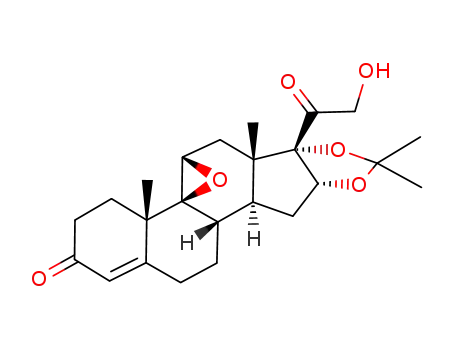
9β,11β-epoxy-21-hydroxy-16α,17-(isopropylidenedioxy)pregn-4-ene-3,30-dione
76-25-5 Downstream products
-
3870-07-3

(11β,16α,17α)-21-acetyloxy-9-fluoro-11-hydroxy-16,17-<1-methylethylidenebis(oxy)>pregna-1,4-diene-3,20-dione
-
3092-61-3

21-Hemisuccinoyl-triamcinolone-acetonide
-
110-99-6

2,2'-oxybis-acetic acid
-
3870-07-3
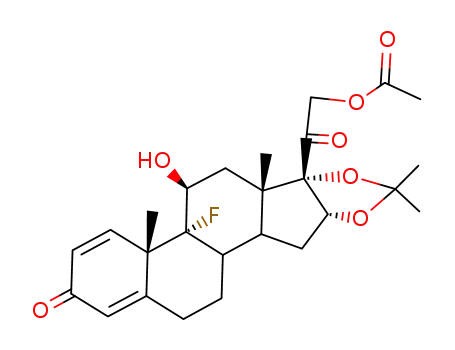
triamcinolone acetonide acetate
Relevant Products
-
Voriconazole
CAS:137234-62-9
-
Flumethasone
CAS:2135-17-3

